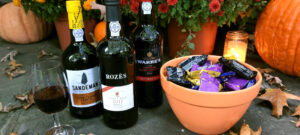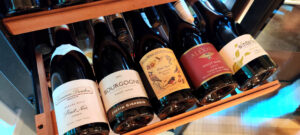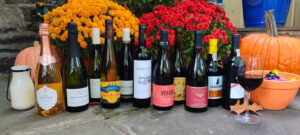As a wine lover and wine professional, I get to see my world through a spectrum of colors and flavors. As the seasons change, what’s in my glass does too.
Autumn always holds a special place in my heart. For one thing, I’m still giddy, even at age 52, that I’ll never have to go back to school again. But also, I long for cool nights, comfy flannels and sitting by the fire pit on my patio, with a heavy red wine. It’s a scene that I dream of all summer long as I sweat through those 90° days.
Wine is not just a beverage; it’s an experience. Opening a bottle is a virtual adventure, transporting you back in years, to another part of the world, to taste a moment in time. When you give wine as a gift, you’re paying that moment forward to the recipient. And when you share a bottle of wine at a gathering, you’re inviting others to take the journey with you.
Here are five personal favorites I’d recommend for almost any autumn, holiday or gift-giving occasion.
1. A Sweet Trick, a Real Treat: Port From Portugal!

Traditionally, Port wine from Portugal was a drink of the wealthy class — something you’d find in a Victorian parlor, being sipped on by monocled men smoking pipes. But this classic has two special qualities that make it relevant for the season: One, it’s naturally sweet; two, it’s fortified with brandy, so it’s higher in alcohol.
Both of these qualities make Port a great match for sweets, especially chocolate. Can you tell where I’m going with this?
The two main styles are Ruby and Tawny. Ruby is as the name implies — young and fresh, with flavors of cherry, strawberry and raspberry. When paired with milk chocolate, the combination is like a cherry cordial with the volume turned up! Combined with a peanut butter cup, it’s like an adult PB&J. Grab a bag of Halloween candy and have some fun.
Tawny Port is aged in barrels for slightly longer, and, therefore, the flavor is more savory, brimming with butterscotch, caramel and toffee, which makes it great with cheeses, cakes and tarts. Try it with English Stilton, a slice of cheesecake or freshly baked blondies!
The best news is that the average bottle of Ruby and Tawny Port will only set you back about $20. But if you’re looking for something a little more elevated, Port can go there too. Vintage Ports are higher quality, only made in exceptional years and can rise above $100 a bottle.
UNIQUE GIFT IDEA: In some cultures, it’s traditional to buy a Vintage Port from a person’s birth year and give it to them on their birthday!
2. Pinot Grigio Gets Dressed Up for the Holidays: Pinot Gris

Considering Italian Pinot Grigio is the world’s top-selling white wine, you’ll probably never be turned away from a party if you show up with a bottle. But if you feel like that’s just not trying hard enough, Pinot Grigio actually has a classy relative known as Pinot Gris. What’s the difference? Pinot Gris came first — from France, where it’s used in both Burgundy and, believe it or not, Champagne.
French Pinot Gris tends to be a lot more full-bodied and richer than its Italian counterpart, bringing a heady nose of stone and tropical fruits, along with a hint of flinty minerals. It’s an excellent wine for oysters, mussels and shellfish. And with a few years of age, flavors of baked pineapple and apple start to show, which is why it’s amazing with glazed ham and baked white fish. For a touch of added sweetness, you can even pair it up with apple or pecan pie for holiday meals.
SOMETHING OLD: Alsace, France, has some of the best original examples of French Pinot Gris. Producers like Willm and Zind-Humbrecht will set you back $20-$35.
SOMETHING NEW: Oregon also makes great versions of French-style Pinot Gris. Van Duzer Vineyards ($23) is one of my favorites.
SOMETHING DIFFERENT: “Gris” and “Grigio” both mean “gray” and refer to the reddish-pink color of the grape’s skin. Northern Italy’s Friuli region makes a Pinot Grigio “Ramato,” a copper-colored wine that has more tannins and body. This is technically called an “Orange wine,” and it’s a funky, fun gift to give if you want something really unique!
3. Pinot Noir IS Autumn in a Glass!

If you enjoy the smell of leaves on the ground, a whiff of smoke in the air and a cornucopia of fall flavors on your table, Pinot Noir is hard to beat as the quintessential wine of autumn. This noble red grape from Burgundy, France, has been enjoyed for over 2,000 years and has stood the test of time because it’s delicious, affordable and versatile. The best-quality wines can be found in cooler regions of the world like New Zealand, the coasts of Chile and California, and Oregon.
When served young, Pinot Noir is light, fresh and most remarkable for its potpourri of red fruit flavors — cranberry, strawberry and raspberry. As it ages in the bottle, those fresh, vibrant tones mellow out and reveal earthy notes of truffle, mushroom, dried herbs and spice.
If you’re picking up on the Thanksgiving vibes here, you’re not wrong. Young or old, Pinot can complement almost any cool-weather meal. It’s amazing with roasted poultry, buttery mashed potatoes and root vegetables (especially sweet potatoes and beets). Older, more savory styles can complement everything from coq au vin to herbed mussels and escargot. In Burgundy, it’s classically paired with salmon.
AFFORDABLE LUXURY: Village-level wines (Mâcon-Villages and Côte de Beaune) from Burgundy producers like Louis Jadot and Joseph Drouhin, will cost around $20-$25.
POWER PINOTS: Oregon is making some of the world’s best and most-elevated New World Pinots out there. Look to the Willamette Valley and Dundee, in the $40-$50 range. I personally like Ponzi and Adelsheim, two of the original producers in this region.
4. Surprise the Person/Couple Who Has It All: Bring Spanish Mencía

When it comes to more well-off and well-traveled friends, it may seem like there’s nothing new we can show them. Out of all the people you know, they’re the ones most likely to have a wine cellar stocked with the good stuff: Bordeaux, Burgundy, Napa, Tuscany, etc. So how are you going to impress THOSE people?
Trust me, even the worldliest person can learn a few things, and I’m willing to bet they’ve never heard of this one: Mencía.
Mencía is a red grape from the Galicia region of northwestern Spain, that little tab of land that looms over top of northern Portugal. The grape is native to the region; sadly, during the Second World War, and then Francisco Franco’s ensuing dictatorship, many Spaniards abandoned Galicia and left their vines behind. It was only decades later, when Spain joined the European Union and the industry returned, that they realized what a regional treasure they had.
Mencía makes for full-bodied, perfumed red wines that can age for a long time: And for that reason, your wine-collecting buddies are going to love it. More affordable versions are great everyday drinkers that pair amicably with burgers and dogs around the fire for autumn camping excursions. And at its best — typically when made from the original ancient vines — it can be on par with some of the greatest bold reds in the world, maturing in the cellar for decades.
FOR A CASUAL PARTY: Because it’s still not very well known, Mencía can be very affordable at $20-$25 a bottle.
GO BIG: If you really want to impress your friends, go all out with a producer like Alvaredos-Hobbs ($79) or Bodegas Raul Perez ($100).
5. It’s Not a Party Without Sparkling Wine…

…But let’s skip the obvious, shall we, and try something a little different? Yes, Champagne is the best sparkling wine in the world, but you already know that.
This time of year is a whirlwind, and you’re most likely going to be hosting and attending A LOT of gatherings before the year is over. So how about something more accessible and just as “gouleyant” (that’s French for “gulpable”)?
When the price tag is less important, I go for French Crémant. Crémant is like Champagne’s Cinderella sister: full of grace and charm but rarely gets the attention. It can be made in eight major regions around the country, and the production standards are typically the same as Champagne: using only the best hand-picked grapes, fermented in the bottle and cellar-aged for a length of time.
Crémant (the name refers to the creamy bubbles) has been around since the Middle Ages, and some even argue it existed before Champagne. It can be found in white, rosé and even red (Crémant de Bordeaux and Crémant de Loire) versions — typically dry but sometimes sweet. For dry wines, look for “Brut” and “Brut Nature.” Sweet wines will be labeled “Doux” or “Moelleux.”
Sparkling Crémant is perfect for cocktail hours and appetizer courses. It’s light and airy and won’t weigh guests down. It complements sweet, salty and fatty foods, which makes it a great starter — and a great finisher too. Plus, it’s just a lot of fun to drink!
INSIDER TIP: My personal go-to region is Burgundy, labeled as “Crémant de Bourgogne.” Why? Because this region uses several of the same grapes as nearby Champagne — like Pinot Noir and Chardonnay. Grab a high-quality version (like an Albert Bichot Brut Reserve, $24.99), and you’re essentially getting a fine Champagne for one-third of the price.
The Joy of Wine Is in the Journey, so Have Fun

I enjoy the challenge of finding the perfect wine(s) for every palate, budget and occasion. And I have two basic rules for doing my job: No matter what the price is, it should taste great, and — whenever possible — show people something they wouldn’t normally try.
Keeping an open mind and approaching the task with a sense of joy is all part of the adventure. After all, that is the spirit of this time of year! The last thing we need is for those special celebrations to feel like another task. Hopefully this simple guide has given you some seasonal ideas that you and your fellow wine lovers can relax and have fun with.
Enjoy the rest of the year — and your wine. Cheers!

